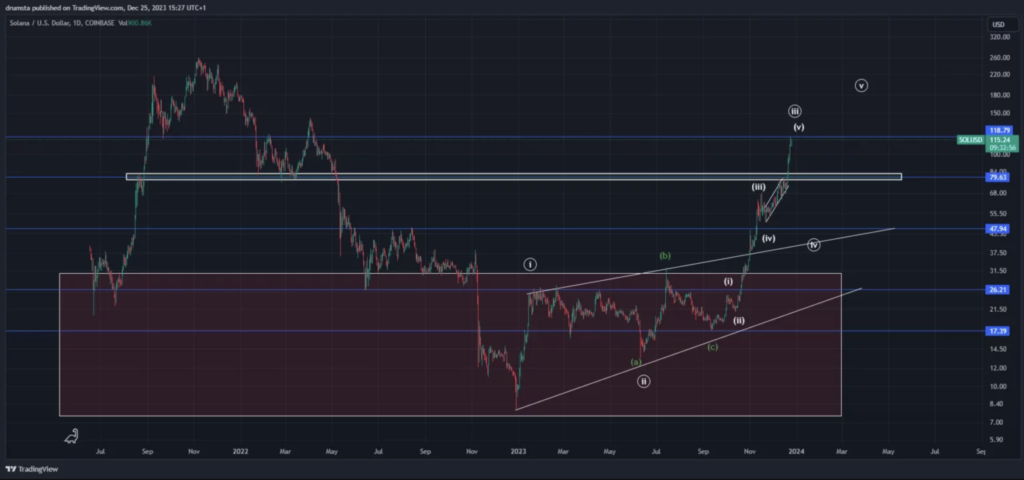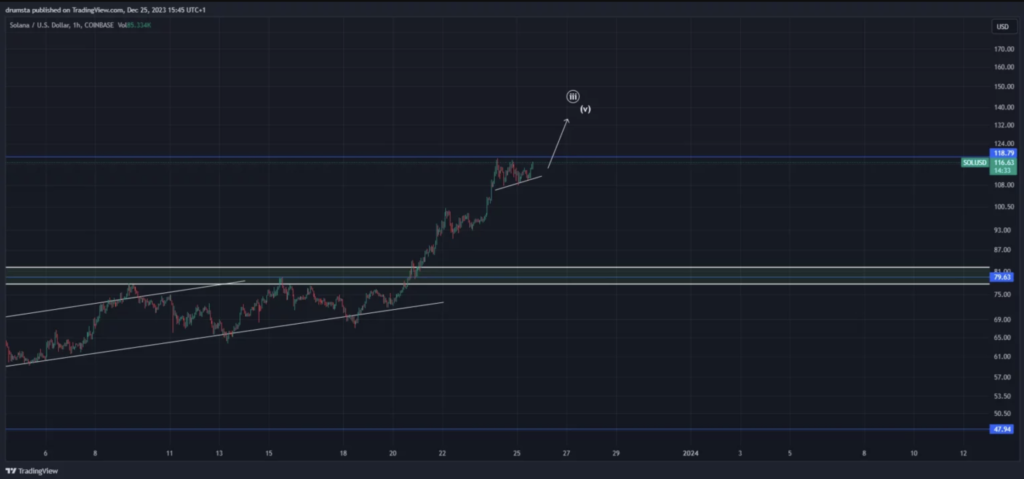What is Solana ? Why is Solana’s price increasing in December 2023 ?
Dec 26, 2023 13:03 UTC
| Updated:
Dec 26, 2023 at 13:03 UTC
Solana (SOL) represents a blockchain network created to support decentralized and scalable applications. Launched in 2017, it operates as an open-source project overseen by the Solana Foundation, headquartered in Geneva, with the technical development managed by Solana Labs based in San Francisco.
Distinguishing itself from other blockchains like Ethereum, Solana boasts rapid transaction processing capabilities and notably lower transaction fees. Its native cryptocurrency, also named Solana (SOL), skyrocketed by nearly 12,000% in value during 2021, briefly reaching a market capitalization exceeding $75 billion, positioning it among the top cryptocurrencies at the time.
However, despite its surge, SOL encountered the market downturn of 2022. By December 29, 2022, SOL’s market capitalization had dwindled to approximately $3.63 billion. Yet, within a year, it managed to recuperate nearly half of the market value it had previously lost.
Key Highlights:
- Solana serves as a platform for scalable and decentralized applications.
- Solana has reached price levels reminiscent of April 2022.
- It surpassed Ripple and subsequently Binance Coin in market capitalization.
- It stands out with its ability to handle a significantly higher number of transactions per second and lower transaction fees compared to rival blockchains like Ethereum.
- Solana operates on a proof-of-stake (PoS) model but enhances this with a mechanism called proof-of-history (PoH), utilizing hashed timestamps to validate transaction timing.
- Chart analysis indicates a significant surge, marking a higher high at $146.
Why is Solana (SOL) price up this week?
The rise in SOL’s price seems to be influenced by Ethereum’s increased gas fees and Solana’s distribution of airdrops like Bonk. Solana’s ticker symbol SOL has surged by over 60% during the week ending on December 24, reaching $118, marking its first time hitting this value in eighteen months.
Solana Price Analysis
Solana’s price hit its lowest level since the all-time high on December 29, 2022, dropping to $8. It underwent consolidation, encountering resistance around $30 while forming higher lows. Eventually, the price surged above this resistance towards the end of October.

In a broader upward trend, the current upward movement began around September 13, likely constituting wave 3 within a five-wave impulse pattern starting from the $8 low. Solana recently reached its first lower structure after the all-time high at $80, presenting another resistance point. While the price appears overextended, reaching a potential stopping point, there are no immediate signs of struggle indicating an imminent downturn.
Solana Price Prediction
On the hourly chart, indications of resistance are visible as the price has maintained a sideways movement since reaching yesterday’s peak. However, the ascending support suggests an increase in buying pressure, hinting at a potential breakout.
A move towards a higher high, possibly reaching $146, seems probable. In the short term, SOL’s price may aim for another high around the $146 area, supported by the previous daily chart pattern. Yet, this could mark the conclusion of the current upward trend, prompting a correction for a larger wave 4.
The exact outcome of this correction remains uncertain despite numerous resistance levels being breached. However, the most notable resistance lies at approximately $80, which could serve as the initial target for the price to retrace. If this scenario unfolds and the price finds support around $80, it might initiate another upward trend for a larger wave 5, potentially leading to a new all-time high at the beginning of 2024.

Solana’s Ranking Among Cryptocurrency Companies: How Solana (SOL) flips BNB and XRP to become fourth biggest coin in December 2023
Airdrops on Solana boost’s User Activity on Solana Network
What is History of Solana(SOL)
Anatoly Yakovenko, a co-founder of Solana, brought forth his expertise in distributed systems design gained from notable companies like Qualcomm Incorporated (QCOM). His understanding emphasized the importance of a dependable clock in simplifying network synchronization. Yakovenko recognized that a well-synchronized network could potentially achieve exponential speed, limited only by its bandwidth.
Yakovenko’s insight led to the conception of proof-of-history, a mechanism he believed could significantly enhance the speed of blockchain networks compared to systems like Bitcoin and Ethereum, which lacked clocks. These existing systems faced challenges in scaling beyond 15 transactions per second (TPS) globally, a stark contrast to centralized payment systems like Visa, capable of handling peaks of up to 65,000 TPS.
By introducing proof-of-history, Yakovenko aimed to overcome this limitation, ensuring that every node within the network could rely on the accurately recorded progression of time.
The Concept of Proof-of-History
Anatoly Yakovenko introduced the proof-of-history (PoH) concept in a white paper published in November 2017. PoH operates by confirming time passage between events, encoding this timeline into a ledger to facilitate consensus within the blockchain.
Yakovenko highlighted that existing blockchains at that time didn’t rely on a standardized time source. Each node within the network operated on its own local clock, lacking synchronization with other participants. This absence of a universally trusted time reference led to discrepancies when using message timestamps for accepting or rejecting messages, as there was no assurance of uniform decision-making across the network.
Further Development
In 2018, Yakovenko assembled a team of five individuals to co-found a project initially named Loom. However, due to potential confusion with an Ethereum-based project sharing a similar name, they opted to rebrand it as “Solana,” inspired by a small coastal town near San Diego where the co-founders had previously resided.
The project underwent scaling in June 2018, transitioning to operate on cloud-based networks. Within a month, the team launched a public test net capable of supporting bursts of 250,000 transactions per second (TPS).
As of December 12, 2023, Solana had processed an impressive count of over 253 billion transactions, averaging a cost of $0.00025 per transaction. Additionally, Solana introduced its own token standard called SPL Token, resembling Ethereum’s ERC-20 standard for tokenization.
Explanation
Anatoly Yakovenko’s PoH concept revolutionized blockchain technology by incorporating a mechanism that tracks time passage between events, enhancing consensus and addressing the lack of synchronized time across nodes in existing blockchains. This innovative approach aimed to ensure uniform decision-making based on a shared understanding of time, a crucial aspect in blockchain operations.
Following the conceptualization of PoH, the project, initially named Loom, evolved into Solana, scaling up its capabilities to operate on cloud-based networks and achieving a remarkable milestone of supporting 250,000 TPS in its public test net.
Solana’s impressive transaction volume and cost-efficient processing further cemented its position as a formidable player in the blockchain space, complemented by the introduction of its own token standard, SPL Token.
The Technology Behind SOLANA

Comments are closed.